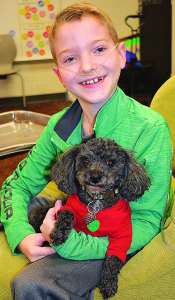
It’s tough being the new kid in school. It’s probably even tougher when a medical condition makes you stand out in the classroom and hallways.
That’s why the students at Oxford Elementary School (OES) have been working extra hard to make fifth-grader Gavin Lawrey, who moved here from Cape Coral, Florida, feel welcome by raising awareness and funds to help fight the deadly disease he faces every day.
“It’s really amazing how these kids have heard his story and rallied around him,” said Lawrey’s teacher, Jodie Viviano. “They are going out of their way to make sure that he knows that we care about him.”
His mother Brandi Lawrey said “starting a new school was definitely something that was a little bit scary” for her son “and a little overwhelming.”
But the “extra effort” put forth by students and staff to make Gavin feel understood, included and loved has made all the difference in the world during this big transition.
“(They have been) incredibly kind . . . He’s feeling more supported and appreciated than ever,” Brandi said. “He’s excited to go to school. For a long time, school (was) a little bit frustrating for him. He’d have a hard time remembering things. (But) I think he just feels so supported and so loved (at OES) that he’s not worried about not being able to do something.”
Gavin, 11, has mitochondrial disease, an incurable, progressive, genetic disorder that affects people who have it at the cellular level.
Every cell, with the exception of red blood cells, contains mitochondria, structures that serve as tiny powerhouses by converting oxygen and food into the energy needed to keep the body alive and organs functioning. Ninety percent of the body’s energy comes from mitochondria.
Mitochondrial disease causes these powerhouses to fail and as the amount of energy they produce diminishes, cells are damaged and die.
“If this process is repeated throughout the body, whole organ systems begin to fail,” according to the United Mitochondrial Disease Foundation (UMDF). “The parts of the body, such as the heart, brain, muscles and lungs, requiring the greatest amount of energy are the most affected . . . (The disease) affects each individual differently. Symptoms can include seizures, strokes, severe developmental delays, inability to walk, talk, see and digest food combined with a host of other complications.”
The UMDF reports that every year, 1,000 to 4,000 children in the United States are born with mitochondrial disease, but the exact number of children and adults suffering from it is “hard to determine” because “so many” of them are “frequently misdiagnosed.”
“I’d never heard of (mitochondrial disease) before,” Viviano said. “His mom has been really great about informing the kids about what he has and how it affects him.”
Gavin’s condition is terminal and he’s been in hospice for about four years, according to Brandi.
She and her husband, Jeff, are originally from Oakland County (Ferndale and Royal Oak, respectively), so they moved to Oxford, after spending 13 years in Florida, to be closer to family and bolster their support system.
Gavin’s classmates wanted to stand behind him so they conducted a schoolwide campaign last week as part of Mitochondrial Disease Awareness Week.
“We wanted to kick in and help,” Viviano said.
Everyone was encouraged to wear green, the color that represents mitochondrial disease awareness. Posters containing facts about the disease were created and displayed prominently around the school.
“They just ran with it,” Viviano said.
“The kids actually took the time to learn about (mitochondrial disease) . . . (and) teach the other kids about it. I thought that was really impressive,” Brandi said.
All these efforts made Gavin feel “special.”
“I think it was very nice (of them),” he said.
Students also brought in whatever money they could spare to aid Gavin’s 14-year-old sister, Makenzie, in her quest to raise $1 million for the fight against mitochondrial disease.
OES raised $903, which will be donated to the UMDF to support research efforts.
“I had kids that were bringing in their Tooth Fairy money (and) the money they get from (doing) chores,” Viviano said.
A freshman at Oxford High School, Makenzie began her “Hope 4 Mito” fund-raising campaign at the age of 9. The web address is www.hope4mito.org.
Overall, Makenzie’s campaign has been quite successful. “She’s raised a little over $300,000,” Brandi said.
Viviano is “so proud” of the way her students and the rest of the school pitched in to support Gavin, his fight for life and the larger battle against a devastating disease that affects so many.
“Our community is close-knit and we take care of our own, but this has just been amazing,” she said.

Even though Gavin started exhibiting symptoms when he was just 18 months old, he wasn’t diagnosed with mitochondrial disease until the age of 4½.
He suffers from seizures, pain that’s severe and chronic, neuropathy and a compromised immune system that makes it easy for him to get sick and requires some extra precautions.
“Every Friday, (his) entire class cleans their classroom,” Brandi noted. “Their rule is they clean anything they think Gavin can touch. They want to keep the classroom clean so that Gavin can stay healthy. I love the fact the kids get involved to (make) it a safe environment for Gavin.”
Gavin also struggles with breathing, which requires oxygen therapy, and was diagnosed with early onset dementia.
“Sometimes he remembers things and sometimes he doesn’t,” Brandi said. “In school, one day he can read, but then the next day, he forgets how to read.”
Although Gavin uses a wheelchair, Brandi said he can still walk. “He just can’t walk long distances” as his legs are weak and tend to shake, which causes him to fall “a lot,” she explained.
In addition to his wheelchair, Gavin also has a service dog – an adorable toy poodle named Hershey – who warns him when he’s about to have a seizure and when his oxygen level is low.
Due to his body’s lack of energy, Gavin spends a good portion of his days sleeping.
Despite all these health issues, Brandi described her son as an “incredibly positive” person who is always smiling and trying to make everyone around him do the same.
“He’s very funny. He gets through tough times by making jokes,” she said.
Gavin is also quite selfless.
“He’s always more worried about how everyone else is,” Brandi said.
For example, last week, Gavin was ill and missed three days of school during Mitochondrial Disease Awareness Week.
“He was concerned. He felt bad. He felt like he let his classmates down. I had to explain to him that they understand and that’s why they’re doing this,” Brandi said.
Some may wonder why Gavin still attends school when his future is so uncertain.
“We want him to live as normal of a life as he possibly can and part of that is just being a kid,” Brandi explained.
Besides, Gavin wants to be at school, surrounded by kids his own age, according to his mom. “He’s a very social child,” she said. “He loves to be around people. He loves to entertain people. He likes to make people laugh. I think the classroom gives him his own little stage in his mind. He’s constantly cracking jokes in class and making all the kids laugh.”
“(Going to school is) something he loves and he wants to do, so . . . we’re fully going to support him,” Brandi added.

Leave a Reply